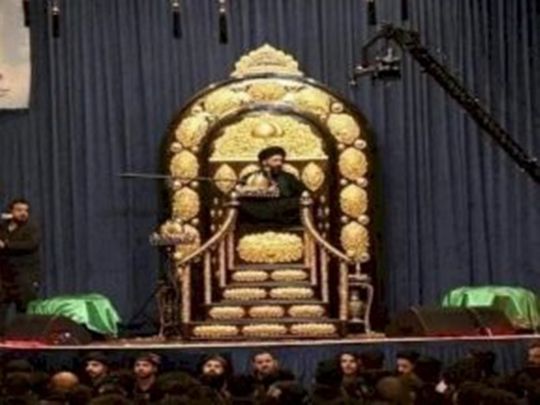
Abu Dhabi: The appearance of Shiite cleric on a $1 million gold platform sparked widespread outrage in Iraq at a time when the country is suffering from a stifling financial crisis and a dangerous rise in poverty.
The sight prompted an angry attack on a hussainiya, the Shiite place where the platform was built, local media reported.
The opening of the gold minbar, a raised platform in the front area of a mosque from which sermons are given, at Zahraa Palace in Baghdad ignited anger on social media, with users calling for the donation of its price to the poor.
The minbar, also known as pulpit, is located to the right of the mihrab, which marks the direction of the qiblah for prayer. The minbar is usually made of carved wood, stone, or brick.
It includes a short staircase leading to the top platform, which is sometimes covered by a small dome. At the bottom of the staircase there may be a gate or doorway. The cleric walks up the steps and either sits or stands on the minbar, while addressing the congregation.
In addition to making the speaker visible to worshippers, the minbar helps to amplify the voice of the speaker. In modern times, microphones are also used for this purpose. The traditional minbar is a common element of Islamic mosque architecture throughout the world.
The Shiite cleric Ali Al Talqani delivered this week a religious lecture from that minbar, marking the anniversary of the death of Fatima Al Zahra, the Prophet’s youngest daughter from Khadijah, in the presence of dozens of people.
Supporters of the leader of the Sadrist movement attacked the Husaeiniya on Sunday, shutting it down by force and dismantling the pulpit, while no position has yet been issued by the country’s supreme Shiite authority, Ali Al Sistani, on this doctrinal platform, and whether this is consistent with or contradicting Islamic teachings.
The Sadrist movement has not announced how it will act with the minbar’s gold and precious stones, and where it will go.
The appearance of the cleric on the sectarian pulpit, which is encrusted with gold, sparked widespread Iraqi popular anger.
Activist Hassan Al Haj wrote: “One of the faithful politicians was asked, one day, about the cost of building a 6,000-square-meter mosque in the most prestigious area in Baghdad, which cost $36 million, and he replied that it was a donation from a believer, may God reward him.”
Najia Sadiq considered the pulpit as representing “the thieves of religion.”Abdul Latif Mohsen asked: “Why are you surprised, when the Shirazis are the richest Shiite sect and the money that comes to them is very large and they are the only ones who have the largest amount of satellite channels in Iraq and the world?”
Maysa Al Azzawi commented, “Had Prophet Mohammad ever ascended a pulpit encrusted with gold? How had he convinced the poor with asceticism, patience and supplication to God, and now the Shiite build a platform that can end the hunger of a large group of people? “
Abu Mohammed expressed his dissatisfaction. He said: “He sits on a gold platform until he calls people for asceticism and piety, and concludes with prayers for the poor and needy.”
Rafid said, “A small piece of food in the stomach of a hungry is better than building a thousand mosques.”








